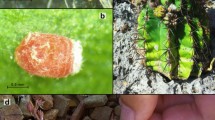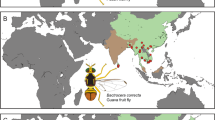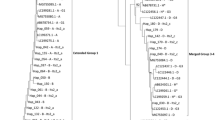Abstract
It has been proposed that true fruit flies in the Rhagoletis pomonella species group speciate sympatrically (that is, in the absence of geographic isolation) as a consequence of shifts to previously unexploited host plants1,2. Because Rhagoletis larvae are host-specific fruit parasites and mate selection in these flies is directly coupled to host-plant recognition3–5, variation for larval survivorship and host preference traits can act as genetically based barriers to gene flow. This reduction in gene flow results in the sympatric divergence of fly populations adapted to alternative hosts. The shift of R. pomonella from its native host hawthorn (Crataegus spp.) to domestic apples (Mains pumila) in eastern North America in the past 200 years6 provides an opportunity to determine whether host specialization is sufficient to differentiate populations without earlier periods of geographic isolation. We report finding genetic differentiation between co-occurring hawthorn and apple populations of R. pomonella at a field site near Grant, Michigan. The result confirms that hawthorn and apple flies represent partially reproductively isolated 'host races' and is consistent with a sympatric mode of divergence for these flies.
This is a preview of subscription content, access via your institution
Access options
Subscribe to this journal
Receive 51 print issues and online access
$199.00 per year
only $3.90 per issue
Buy this article
- Purchase on Springer Link
- Instant access to full article PDF
Prices may be subject to local taxes which are calculated during checkout
Similar content being viewed by others
References
Bush, G. L. The Taxonomy, Cytology and Evolution of the Genus Rhagoletis in North America (Diptera, Tephritidae) (MCZ, Cambridge, Mass., 1966).
Bush, G. L. Evolution 23, 237–251 (1969).
Bush, G. L. A. Rev. Ecol. Syst. 6, 339–364 (1975).
Prokopy, R. J., Bennett, E. W. & Bush, G. L. Can. Ent. 103, 1405–1409 (1971).
Prokopy, R. J., Bennett, E. W. & Bush, G. L. Can. Ent. 104, 97–104 (1972).
Walsh, B. J. Hort. 2, 338–343 (1867).
Cockerham, C. C. & Weir, B. S. Genet. Res. 30, 121–147 (1977).
Laurie-Alhberg, C. C. & Weir, B. S. Genetics 92, 1295–1314 (1979).
Berlocher, S. H. & Smith, D. C. J. Hered. 74, 337–340 (1983).
Reissig, W. H. & Smith, D. C. Ann. Ent. Soc: Am. 71, 155–159 (1978).
Felsenstein, J. Heredity 35, 124–138 (1981).
Prokopy, R. J., Diehl, S. R. & Cooley, S. S. Oecologia 76, 138–147 (1988).
Prokopy, R. J., Averill, A. L., Cooley, S. S. & Roitberg, C. A. Science 218, 76–77 (1982).
Diehl, S. R. thesis, Univ. Texas at Austin (1984).
Smith, D. C. Nature. 336, 66–67 (1988).
McPheron, B. A., Smith, D. C. & Berlocher, S. H. Nature 336, 64–66 (1988).
Berlocher, S. H. & Bush, G. L. Syst. Zool. 31, 136–155 (1982).
Author information
Authors and Affiliations
Rights and permissions
About this article
Cite this article
Feder, J., Chilcote, C. & Bush, G. Genetic differentiation between sympatric host races of the apple maggot fly Rhagoletis pomonella. Nature 336, 61–64 (1988). https://doi.org/10.1038/336061a0
Received:
Accepted:
Issue Date:
DOI: https://doi.org/10.1038/336061a0
This article is cited by
-
Hybridisation between host races broadens the host range of offspring in Eotetranychus asiaticus (Acari: Tetranychidae)
Experimental and Applied Acarology (2023)
-
Non-parallel morphological divergence following colonization of a new host plant
Evolutionary Ecology (2022)
-
Fighting about frequency
Synthese (2021)
-
Host range expansion of a Polygonaceae-associated leaf beetle to an invasive aquatic plant Myriophyllum aquaticum (Haloragaceae)
Arthropod-Plant Interactions (2020)
-
Speciation Post Synthesis: 1960–2000
Journal of the History of Biology (2019)
Comments
By submitting a comment you agree to abide by our Terms and Community Guidelines. If you find something abusive or that does not comply with our terms or guidelines please flag it as inappropriate.



